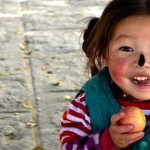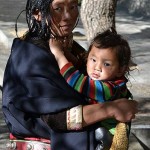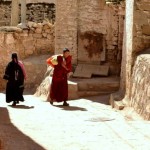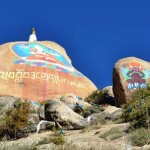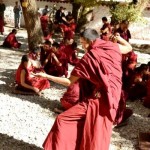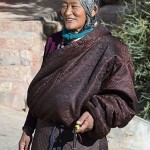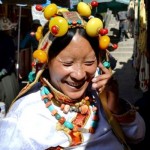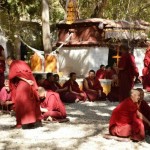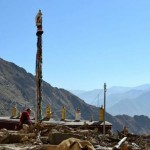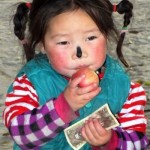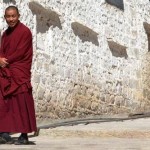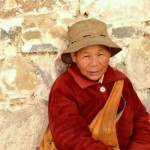Seven days in Tibet – episode 7
LHASA – last day
It is the third and the last day in Lhasa, and the quarrel some monks are waiting for us at Sera monastery. Let’s wait, because the program fixed by the Tibetan agency begins with a visit to Drepung, the largest monastery in Tibet, lying on 2.000 square meters, 10km far from the city. Drepung hosted the first four Dalai Lamas and beginning with the early fifteenth century has been an important academic center for Gelukpa sect, as Serahas been. Monks graduated and got its diplomas after twenty years of Buddhist study. In the Drepung where I entered, Buddha has replaced by the Chinese intelligence, drowned in blood after the riots that took place here three years ago. And this aspect is very pregnant.
Anything from Oxford’s Tibetan equivalent has left. As a proof, kitchen impresses me at the best, with huge pots of brass embedded in large earthen ovens and high bowls for preparing the nak butter, all designed as a community of thousands of people. Maybe it’s just my ignorance. I found that even at Buddhists, there is monasticism. Under Mani rocks, painted in bright colors, some nuns are living. One of our hiking colleagues is invited in a cell, then trying to share her experience, but it’s no purpose, this only should be lived. I benefit, however, of some sweets dehydrated nak milk, and cooked by the monk, and this soften the bitter taste left by what I have seen.
- Șapte zile în Tibet – Lhasa
- Șapte zile în Tibet – Lhasa
- Șapte zile în Tibet – Lhasa
- Șapte zile în Tibet – Lhasa
- Șapte zile în Tibet – Lhasa
- Șapte zile în Tibet – Lhasa
But bitterness is also at Sera, where almost everything is closed, the tourism destination’s air taking place the fragrance of wild roses – sera in Tibetan – from the golden old days of the monastery. Sera hasthe same fate as Drepung’s. Because the hundreds of monks were killed, many of the old texts and religious artifacts were destroyed in the ’59 bombing, the monastery forever loses its status of important Buddhist teaching center, that has been maintained and developed over five centuries. From the six thousand monks, now they are under three hundred.
Nothing from the remained monastery riches are shown. And Sera has 19 hermitages spread over the hills above Lhasa. We visit the typography and the colored sand mandalas room. A chorus of voices that seem very angry calls us to Debates Court. Under trees, learners and teachers, the first seated in the front of others, initiate the Buddhist teaching issues. The gestures accompanying debate, also the voice tone and the volume, make you think they argue. But I know that every gesture has a meaning and marks the question, the correct response or winner’s debate. All of these is watched in silence by a master. The show is repeated about four times a day. Yes, my impression is about of a slightly directed show.
The real Drepung and Sera gompas are nowadays in the southern of India, where exiled monks have recreated, providing spiritual shelter for nearly ten thousand monks.
Disillusioned, I run to my favorite place from Lhasa, Barkhor market. Once I get my wellbeing dose, all of us start looking for a place for the last Tibetan dinner. And to finish the day in the same spirit it has begun, we go out unwillingly the old center and we enter into a modern neighborhood with many well-known luxury brands known and glass facade buildings. It is a place that I would have preferred not to discover. In a Western restaurant we eat the most spicy food of my life: tandoori chicken, off with a ginger tea with honey and lemon.
- Șapte zile în Tibet – Lhasa
- Șapte zile în Tibet – Lhasa
- Șapte zile în Tibet – Lhasa
- Șapte zile în Tibet – Lhasa
- Șapte zile în Tibet – Lhasa
- Șapte zile în Tibet – Lhasa
Also it comes the morning flight to “home”, as we called Nepal. As we arrive to Lhasa airport before staff boarding, we see them coming to the job, lined in step synchronous. We take time to change the last impressions with Lhakpa and thank for what he could do for us. It could be much better, but I we understand him. After a not so pleasant flight with Air China – we blame the turbulences – we land in Kathamandu, where our friends expect us in Thamel, with Everest beer and bhutanese stories. We also have much to tell them. Now writing these lines, I think I could enjoy more, put more questions, ask to see more than the offered program, return home much richer spiritually. But I think I know why I feel this. It gives me reason to climb back on the roof of the world! Seven days in Tibet, the titled film, reminds about the eight persons I also happily appear with, in the second part. Which I hope will be called The Real Tibet.
The End





